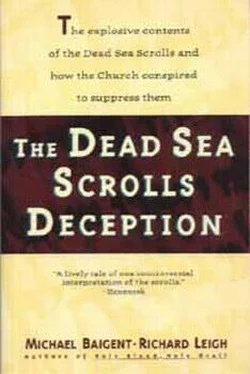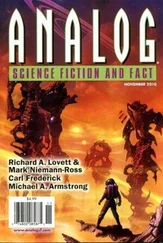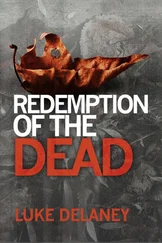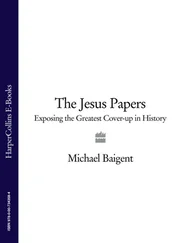There is nothing new or startling about most of these taboos. They can be found in Leviticus 18-20 in the Old Testament. But one of them — that forbidding the king’s marriage to his niece — is new. It is found elsewhere in only one other place, another of the Dead Sea Scrolls, the ‘Damascus Document’. As Eisenman has pointed out, this stricture provides an important clue to the dating of both the ‘Temple Scroll’ and the ‘Damascus Document’ — and, by extension, of course, to the other Dead Sea Scrolls as well. As we have noted, the consensus of the international team regards the Dead Sea Scrolls as pre-Christian, dating from the era of Israel’s Maccabean kings. But there is no evidence that the Maccabean kings — or any Israelite kings before them — ever married their nieces or ever incurred criticism for doing so. 13The issue seems to have been utterly irrelevant. Either marriage to one’s niece was accepted, or it was never practised at all. In either case, it was not forbidden.
The situation changed dramatically, however, with the accession of Herod and his descendants. In the first place, Herod was, by Judaic standards at the time, a foreigner, of Arabian stock from Idumaea — the region to the south of Judaea. In the second place, the Herodian kings made a regular practice of marrying their nieces. And Herodian princesses regularly married their uncles. Bernice, sister of King Agrippa II (ad 48—53), married her uncle, for example. Herodias, sister of Agrippa I (ad 37-44), went even further, marrying two uncles in succession. The strictures in the ‘Temple Scroll’ are thus of particular relevance to a very specific period, and constitute a direct criticism of the Herodian dynasty — a dynasty of foreign puppet kings, imposed on Israel forcibly and sustained in power by imperial Rome.
Taken in sum, the evidence of the ‘Temple Scroll’ runs counter to the consensus of the international team in three salient respects:
1. According to the consensus, the Qumran community had no connection with, or interest in, either the Temple or the ‘official’ Judaism of the time. Like the ‘Copper Scroll’, however, the ‘Temple Scroll’ establishes that the Qumran community were indeed preoccupied with Temple affairs and with the governing theocracy.
2. According to the consensus, the supposed ‘Essenes’ of Qumran were on cordial terms with Herod. The ‘Temple Scroll’, however, goes out of its way to include certain specific strictures — strictures intended to damn Herod and his dynasty. 14These strictures would be meaningless in any other context. 3. According to the consensus, the ‘Temple Scroll’ itself, like all the other Qumran texts, dates from pre-Christian times. Yet the internal evidence of the scroll points to issues that would have become relevant only during the Herodian period — that is, during the 1st century of the Christian era.
The ‘Damascus Document’ was known to the world long before the discovery of the Dead Sea Scrolls at Qumran. In the absence of a context, however, scholars were not sure what to make of it. Towards the end of the last century, the loft of an ancient synagogue in Cairo was found to contain a ‘ geniza’ — a depository for the disposal of worn-out or redundant religious texts’ — dating from the 9th century ad. In 1896, a few fragments from this ‘ geniza’ were confided to one Solomon Schechter, a lecturer at Cambridge University who happened to be in Cairo at the time. One fragment proved to contain the original Hebrew version of a text which, for a thousand years, had been known only in secondary translations. This prompted Schechter to investigate further. In December 1896, he collected the entire contents of the ‘ geniza’ — 164 boxes of manuscripts housing some 100,000 pieces — and brought them back to Cambridge. From this welter of material, two Hebrew versions emerged of what came to be known as the ‘Damascus Document’. The versions from the Cairo ‘ geniza’ were obviously later copies of a much earlier work. The texts were incomplete, lacking endings and probably large sections in the middle; the order of the texts was scrambled and the logical development of their themes confused. Even in this muddled form, however, the ‘Damascus Document’ was provocative, potentially explosive. Schechter published it for the first time in 1910. In 1913, R.H. Charles reprinted it in his compilation The Apocrypha and Pseudepigrapha of the Old Testament.
When Eisenman was given, and passed on to Biblical Archaeology Review, the computer print-out which inventoried all the Qumran material in the hands of the international team, there were listed, among the items, additional versions and/or fragments of the ‘Damascus Document’. Having been found at Qumran, they were obviously much earlier than those of the Cairo ‘ geniza’, and probably more complete. It was the Qumran parallels and the fragments of the ‘Damascus Document’ that Eisenman and Philip Davies of Sheffield requested to see in their formal letter to John Strugnell, thereby precipitating the bitter and vindictive controversy of 1989. Why should this document be such a bone of contention?
The ‘Damascus Document’ speaks firstly of a remnant of Jews who, unlike their co-religionists, remained true to the Law. A ‘Teacher of Righteousness’ appeared among them. Like Moses, he took them into the wilderness, to a place called ‘Damascus’, where they entered into a renewed ‘Covenant’ with God. Numerous textual references make it clear that this Covenant is the same as the one cited by the ‘Community Rule’ for Qumran. And it is obvious enough — no scholar disputes it — that the ‘Damascus Document’ is speaking of the same community as the other Qumran scrolls. Yet the location of the community is said to be ‘Damascus’.
It is clear from the document’s context that the place in the desert called ‘Damascus’ cannot possibly be the Romanised city in Syria. Could the site for ‘Damascus’ have been in fact Qumran? Why the name of the location should have been thus masked remains uncertain — though simple self-preservation, dictated by the turmoil following the revolt of ad 66, would seem to be explanation enough, and Qumran had no name of its own at the time. In any case, it can hardly be coincidental that, according to the international team’s computer print-out, no fewer than ten copies or fragments of the ‘Damascus Document’ were found in Qumran’s caves. 15
Like the ‘Community Rule’, the ‘Damascus Document’ includes a list of regulations. Some of these are identical to those in the ‘Community Rule’. But there are some additional regulations as well, two of which are worth noting. One pertains to marriage and children — which establishes that the Qumran community were not, as Father de Vaux maintained, celibate ‘Essenes’. A second refers — quite in passing, as if it were common knowledge — to affiliated communities scattered throughout Palestine. In other words, Qumran was not as isolated from the world of its time as de Vaux contended.
The ‘Damascus Document’ fulminates against three crimes in particular, crimes alleged to be rampant among the enemies of the ‘Righteous’, those who have embraced the ‘New Covenant’. These crimes are specified as wealth, profanation of the Temple (a charge levelled by the ‘Temple Scroll’ as well) and a fairly limited definition of fornication — taking more than one wife, or marrying one’s niece. As Eisenman has shown, the ‘Damascus Document’ thus echoes the ‘Temple Scroll’ in referring to issues of unique relevance to the period of the Herodian dynasty. 16And it echoes, as we shall see, a dispute in the community which figures more prominently in another of the Dead Sea Scrolls, the ‘Habakkuk Commentary’. This dispute involves an individual designated as ‘the Liar’, who defects from the community and becomes its enemy. The ‘Damascus Document’ condemns those ‘who enter the New Covenant in the land of Damascus, and who again betray it and depart’. 17Shortly thereafter, the document speaks of those ‘who deserted to the Liar’. 18
Читать дальше












